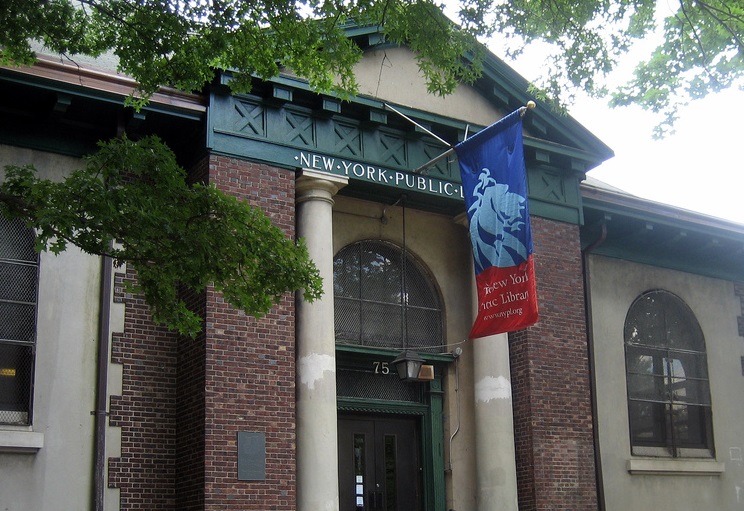
Wally Gobetz
The New York City Public Library's Port Richmond Branch on Staten Island.
New York City’s libraries warn they might have to cut hours if the city doesn’t boost funding to keep up with labor costs—especially new employee benefits like a higher minimum wage and paid family leave.
It’s not just workers who are costing more, library officials say: Books are only becoming more popular as the systems’ attendance grows, but they aren’t getting any cheaper.
The city’s three library systems—the Brooklyn Public Library, the Queens Library and the New York Public Library, which serves the Bronx, Manhattan and Staten Island—say they need $16 million more than Mayor de Blasio’s latest expense-budget proposal of $344 million. They’re also asking for $60 million in capital funding, split equally three ways, as a step toward fixing $1.1 billion in backlogged repair needs.
In its April budget response to the mayor, the Council endorsed both requests. The question now is how much of a priority the libraries will be as the Council and mayor sit down for budget talks before the end of the fiscal year on June 30.
So the libraries are mounting a major push as the final stages of the budget process begin, pumping celebrity endorsements and urging the public to write letters of support. Library officials from the three systems, which together employ 4,000 people and welcomed 35 million visitors in fiscal year 2017, will make official their enlarged request at a City Council budget hearing on Friday.
A boost in service, and demand for it
De Blasio and the Council have done right by libraries in the past. The city significantly boosted the libraries’ budget in fiscal year 2016 and de Blasio “baselined” that amount in the subsequent two fiscal years—meaning he didn’t threaten to reduce it during the annual “budget dance.”
City Hall says de Blasio has also provided $485 million in capital funding.
The increased support for libraries had a substantial impact. The NYPL said it hired 60 librarians who specialize in serving children and young adults. Brooklyn went from 65 percent of branches offering six days of service per week to 100 percent, and Queens from having six-day service in only a third of its locations in 2015 to providing it in every branch last year.
Program attendance at the libraries has grown from 2.2 million in fiscal 2010 to 4.6 million in fiscal 2017, according to the Mayor’s Management Report.
The boom in library usage is visible in many branches. Walk into the temporary location for the Brooklyn Heights library at midday and it’s usually hard to find a seat. At the NYPL branch in Belmont, the shift from ad hoc senior center to makeshift after-school program begins at around 2. At mid-morning, the New Amsterdam branch on Murray Street near City Hall is home to an interesting mix of nannies pushing baby strollers, homeless people looking through the paper, retirees and students—as well as the occasional reporter looking to get WiFi without having to patronize a Starbucks.
The problem is, the costs of providing that service continue to rise. The libraries say early reader picture books and prep books for tests like the selective high school entrance exams are flying off the shelves, forcing libraries to buy more, but at rising costs.
What’s more, progressive policy moves by the city and state—like the rising minimum wage, paid family leave and more—are pushing up personnel expenses. Library officials stress that they fully support those progressive policies, but they come with costs attached.
The push for more funding has union support. “Our public libraries are the jewels of our neighborhoods. They receive more than 40 million visits each year and need to be properly funded to serve our communities, and to do so six days a week. In addition, too many libraries are in disrepair, and need maintenance work urgently,” said District Council 37 executive director Henry Garrido in a statement.
Staff costs dominate
The NYPL is seeking $7 million of the $16 million total. Angela Montefinise, an NYPL spokesperson, wouldn’t provide an exact breakdown for how that additional money would be spent, but indicated that most would go to cover staff costs. The remnant would pay for new books and for small-ticket repair work that city capital funding does not encompass.
“The demand on library services is at an all-time high and in order for the Library to maintain the current level of services we need added funding,” says Val Colon, president of the New York Public Library Guild, Local 1930. “Simple economics tell us that what $43 million paid for in 2016, 2017 is not what it will pay for in 2018 and definitely not what it will pay for in 2019.”
Colon noted that while increases in health benefits are a major concern, and an increased minimum wage may affect a segment of the libraries’ staffing, staff members pay for Paid Family Leave.
City Hall says it has funded collective bargaining increases for all city-funded employees at the libraries, and provided funding for the costs associated with incremental health insurance increases for workers participating in City health insurance plans.
But some library workers are paid, at least in part, with private funds – and that portion of the cost increases has not been addressed by past city funding, Montefinise says.
Minimum wage increases don’t affect union members at the libraries, Montefinise added. But in the case of the NYPL, it does cover some 300 students who work as non-union, hourly pages.
The libraries are independent nonprofit entities that receive government support. City funding comprised just over half the NYPL’s budget in 2017. Private contributions (20 percent), investment income (15 percent) and state/federal aid (7 percent) were also part of the mix.
“This administration greatly values the benefits libraries bring to communities, which is why we’ve increased their budget by 24 percent over five years,” said a City Hall spokesperson. “This new request will be considered as part of the ongoing budget process.”
 Reading Room: Branch Libraries at a Crossroads
Reading Room: Branch Libraries at a Crossroads
Far from obsolete in the digital age, New York City’s libraries are filling critical gaps: offering technology to low-income neighborhoods, a lifeline to immigrants, a safe space for after school. But public funding is down. How long before a lack of support undermines the library system?










One thought on “City’s Libraries Say New Gov’t Policies are Squeezing Their Budgets”
Free access to information is basic to a healthy society. In a day and age when community services moneys are being funneled into wall-building and other divisive, non-productive projects, we have to protect what is one of the foundation blocks of a democratic society.